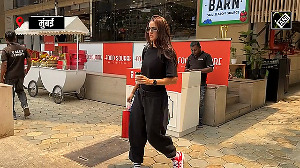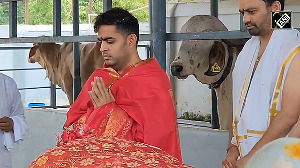The space tourism offer is the prize in a competition that makes no bones about its purpose - drive viewership to the new, youth channel.
If the Bindass promo is "the mother of all contests", media group NDTV's deal with the UB Group is the mother of all co-branding associations. Its recently launched lifestyle channel, Good Times, has deftly interwoven the Kingfisher brand identity with itself - it is no coincidence that Kingfisher's tagline "The king of good times" is remarkably similar to the channel brand.
The Indian cable and satellite universe is already packed and in the coming months it will only get further crowded. Over the next 12 months, another 100 channels will be added to the existing 230 and according to industry estimates, by 2009 a staggering 700 channels could be beamed into Indian homes.
With barely shoving room available for all these channels, how do Good Times and Bindass plan to stand out in the crowd?
The smaller picture
Take a closer look, and the picture improves. According to a recent Ficci-PricewaterhouseCoopers report, television revenues will grow at 22 per cent a year to touch Rs 51,900 crore (Rs 519 billion)
The current size: Rs 19,100 crore (including advertising, subscription and other revenues). The bulk of this growth is likely to come from niche, not general entertainment, channels.
The five general entertainment channels - DD, Star, ZEE, Sony and Sahara - account for only 35 per cent of annual TV advertising, while regional channels take another quarter. That leaves channels broadcasting everything from sports, wildlife to lifestyle with 40 per cent.
Meanwhile, according to the Peoplemeter system of research firm TAM Media, in the past three years, the only genres to have increased viewership are music, news and children's programmes.
The losers: sports and general entertainment. "There is a huge potential for channels offering unique content," agrees L V Krishnan, CEO, TAM Media. And that is the slot Good Times and Bindass hope to conquer.
Mind the gap
Both new entrants are counting on filling unmet customer needs. But with 230 channels already on air, is there really any territory left unaddressed in television programming?
Bindass CEO Zarina Mehta insists there is. "India is a very young country. The 15-34 age group has no channels or entertainment brands addressing it. Bindass is a result of that insight," she says.
The insight is based on a study Synovate conducted for UTV that found almost 30 per cent of those polled (most were in the 15-34 age group) were moving away from general entertainment channels and drifting towards news, lifestyle, Hindi movie and children's channels. (Incidentally, TAM's Peoplemeter confirms that finding: the viewership share of general entertainment channels has dropped from 24.2 per cent in 2004 to 22.4 per cent now.)
Meanwhile, a spike in lifestyle channels' viewership is easily explained: increasing affluence and rising aspirations.
A recent McKinsey report on India's consumer market predicted that by 2025, India's wealthiest group will be 23-million strong. Simultaneously, the middle class will grow almost 12 times, from 50 million now to 583 million by 2025.
That's exactly what Raj Nayak, NDTV Media's CEO, is counting on. "After the basics in life are covered, what you are left with is lifestyle," he points out.
Good Times' agenda is, therefore, simply defined: "A destination for Indians where they can find everything that is included in their definition of lifestyle."
But where Bindass is arguably the first youth-oriented entertainment channel, there's really nothing new about lifestyle programming in India: a dedicated channel, Discovery Travel & Living, has already been around for over three years. That's where content will make a difference. "Our programming will be the biggest differentiator," agrees Nayak.
Unlike DT&L, which offers a mix of international and some local programmes, Good Times has opted for 100 per cent local content.
The thinking behind the strategy: international format local coverage doesn't just cater to viewers' aspirations; it offers them accessible indulgences. (It also offers the channel an opportunity to drive local advertising, but more on that later.)
For instance, a recent show on DT&L featured a traditional Chinese meal, while a food show on Good Times is likely to offer European recipes made with Indian ingredients.
Will the local touch help? Consider this: Good Times launched on 7 September and already has a channel share of 0.06 per cent, on par with DT&L (Source: Tam Media).
Of course, the novelty factor may be responsible for part of these numbers, but Nayak is convinced that he's on to a winning format. "Besides, we are still experimenting and can tweak programmes based on viewers' responses," he points out.
Local flavour is important at UTV, too. Bindass's two channels (movies and youth entertainment) offer a mix of action, comedy and extreme sports - all in Hindi. It seems to be clicking with audiences: launched on 24 September, Bindass claimed a 0.24 per cent share in the first week.
But Bindass's programming strategy is not restricted to going glocal. It is also making its programmes available through mobile phones, and is also extending into gaming, merchandise, retail and events.
The channel has entered into partnerships with mobile service providers such as Airtel, Vodafone, BSNL, Idea, BPL, Aircel, Spice Telecom and MTNL. Subscribers who are linked to these networks can download one- to two-minute long, mobile-specific programmes. "This way we can deliver content exclusively created for the target group," says Mehta.
Will Bindass's strategy work? It is certainly popular internationally. David Jones, global chief of ad agency Euro RSCG, calls this trend "mass individualisation". "Globally, television channels are trying to deliver programming targeted at a focused audience and not necessarily through a television screen," he adds.
It's been tried in India, too, earlier. A few years ago music channel MTV also attempted to extend its offerings beyond television, but with limited success. Industry analysts believe MTV may have been ahead of its time.
The Indian entertainment industry is now maturing, they point out - the growing penetration of internet and mobile services will also act in its favour. "The market is more ready now," says Navin Shah, CEO of branded entertainment agency P9 Integrated. The caveat: Bindass must treat all these avenues as mainstream businesses, rather than add-ons.
The bottomline
The real battle in the television business is fought not over content, but revenues. Advertising still accounts for about 85 per cent of the income of television broadcasters, and that's not likely to change for either Good Times or Bindass.
Which is why both channels are treating their lead advertisers very well indeed. All publicity for the channels is preceded by the sponsors' brands - ITC Foods' Bingo for Bindass, and Kingfisher for Good Times.
NDTV's tie-up with Kingfisher is particularly interesting, not least because this is the first media alliance of its kind in India. As part of the five-year deal, the channel carries the Kingfisher tag and will be aired on board Kingfisher's flights. The UB Group has also committed advertising to the channel (estimated at around Rs 100 crore). "It's much like getting venture capital funding," admits Nayak.
According to industry estimates, the average annual ad revenue of an Indian TV channel is around Rs 30 crore (exceptions like Star Plus's Rs 800 crore annual revenues aside). By that reckoning, Good Times' guaranteed annualised revenues of around Rs 20 crore (Rs 200 million) even before the channel went on air is decent going for a new channel. Besides, it doesn't plan on relying on the Kingfisher deal alone.
The channel also intends tapping into advertisements that are currently controlled by the print media: the local content will help the channel connect better with advertisers, believe analysts.
"With more international luxury brands entering the country, Good Times could also compete for the same ads as, say, Vogue," adds Shashi Sinha, chief executive, Lodestar Universal, a media buying agency.
How does Bindass's advertising strategy compare? While it is specifically targeting youth brands, where it differs from the free-to-air Good Times is in its dependence on subscription revenues.
Bindass launched as a pay channel and has already set up its distribution platform. That's the way forward, believes TAM Media's Krishnan. Even now, subscription revenues are higher than advertising income. Only, routine under-declaration by cable operators means that broadcasters receive only a fraction of their due share.
Now, with more households going the DTH and CAS way, the improved transparency is likely to mean better declaration of subscription revenues. Besides subscription, Bindass is also counting on mobile programming downloads proving a regular revenue stream. "Content exclusively created to the requirements is a critical revenue option," says Mehta without divulging numbers.








 © 2025
© 2025